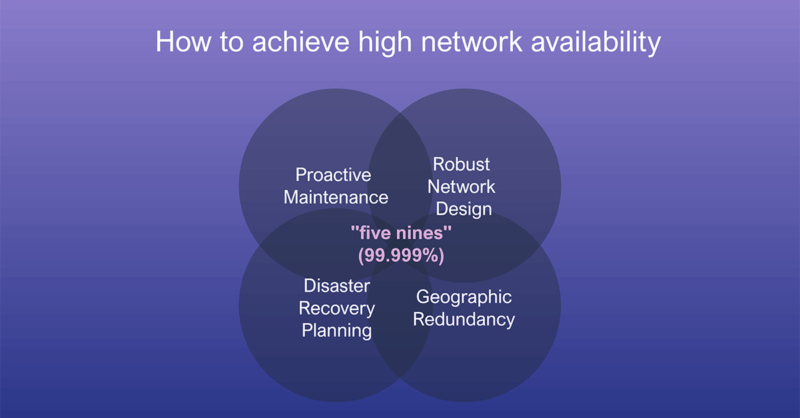
In our increasingly connected world, broadband has transitioned from being a luxury to becoming the very backbone of their operations. This is especially particularly relevant for “mission-critical” applications – those in which even a brief interruption in connectivity can have severe consequences, impacting public safety, essential services, or even national security. When we discuss such networks, the concept of availability shifts from an important feature to an absolute necessity.
Consider this: an unexpected outage can halt an entire business, disrupt life-saving medical procedures, or hinder emergency response efforts. In these scenarios, “best effort” simply isn’t good enough. Mission-critical broadband networks require unwavering performance, which is where the twin pillars of availability and service assurance becomes crucial.
High Availability: The Foundation of Trust
At its core, high availability signifies the capacity of a network to remain functional and accessible when needed. For mission-critical services, this means striving for “five nines” (99.999%) or even higher uptime. While perfect 100% availability is an elusive goal, it is crucial to minimize downtime to mere minutes or seconds each year.
Achieving high availability involves a comprehensive strategy that includes:
- Robust Network Design: Building networks with no single point of failure, utilizing redundant paths, power supplies, and equipment.
- Proactive Maintenance: Regularly inspecting and maintaining infrastructure to prevent potential issues before they cause outages.
- Disaster Recovery Planning: Having well-defined procedures and systems in place to quickly restore service in the event of a major disruption.
- Geographic Redundancy: Distributing critical infrastructure across different locations to mitigate the impact of localized disasters.

When availability is at risk, the repercussions can be significant: financial losses, reputational damage, and, most importantly, threats to public safety and well-being.
Service Assurance: Going Beyond the Basics
While high availability is the foundation of a mission-critical network, service assurance elevates this concept further. It focuses on ensuring that the network not only functions but also reliably provides the expected quality of service (QoS) for designated applications and users. This is especially crucial in mission-critical situations where low latency, high bandwidth, and minimal packet loss are non-negotiable.
Service assurance includes a range of practices and technologies, including:
- Real-time Performance Monitoring: Continuously tracking key performance indicators (KPIs) like latency, jitter, and packet loss across the entire network, typically using the TWAMP protocol for active monitoring.
- Proactive Issue Detection and Resolution: Utilizing intelligent tools and automation to identify anomalies and potential problems before they impact services, and then rapidly
addressing them. - Root Cause Analysis: When an issue does occur, precisely identifying the root cause to prevent recurrence.
- SLA Management: Ensuring that the network consistently meets agreed-upon Service Level Agreements (SLAs) with customers, especially those relying on critical applications.
Consider a hospital that depends on a broadband connection for conducting remote surgeries or for critical patient monitoring. While high availability is expected, service assurance guarantees that the connection reliably provides the low latency and high bandwidth necessary for real-time video and data transmission, preventing any delays or interruptions that could potentially have life-threatening consequences.
Transport Specific Challenges in Mission Critical Broadband
When migrating to mission-critical broadband, a common mistake is to assume that the management and monitoring of the network will be similar to that of a voice-oriented transmission network. However, mission-critical broadband transport networks present distinct challenges:
- Visibility: Unlike voice networks, where simply monitoring link status is sufficient, data networks experience sudden bursts, packet drops, and significant delays, impacting delay-sensitive applications like push-to-talk. Operators need monitoring tools capable of tracking end-to-end network status in terms of delay, jitter, and packet loss.
- Confidence: Mission-critical wireless broadband networks are commonly built utilizing existing infrastructure from a third-party mobile operator for the radio access network. Thus, a critical communications operator lacks direct visibility into that network. Therefore, the ability to verify end-to-end Service Level Agreement (SLA) requirements over the third-party network is crucial to ensure necessary service quality.
- Proactiveness: Unavailability of mission-critical broadband services is unacceptable. Operators must be able to anticipate issues before they affect end-users. Analyzing historical data helps identify trends and hotspots, enabling network reconfiguration or capacity additions where needed in order to adapt to evolving demands for the network, as there are more applications running on the networks, such as data-intensive mission-critical video.
The Bottom Line
For mission-critical broadband, the stakes are simply too high to compromise on availability and service assurance. These factors extend beyond mere technical aspects; they are essential requirements for safety, productivity, and progress in an increasingly digital world. By prioritizing robust design, proactive monitoring, and intelligent management, network operators are able to build and maintain the resilient, high-performing networks that our interconnected future demands.
